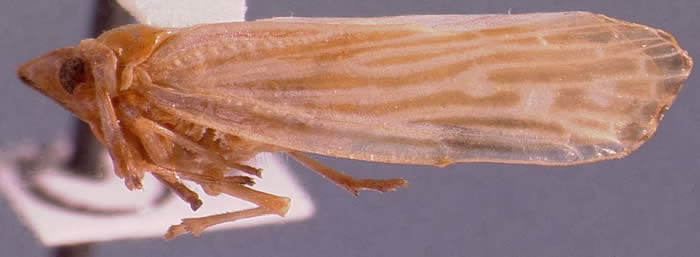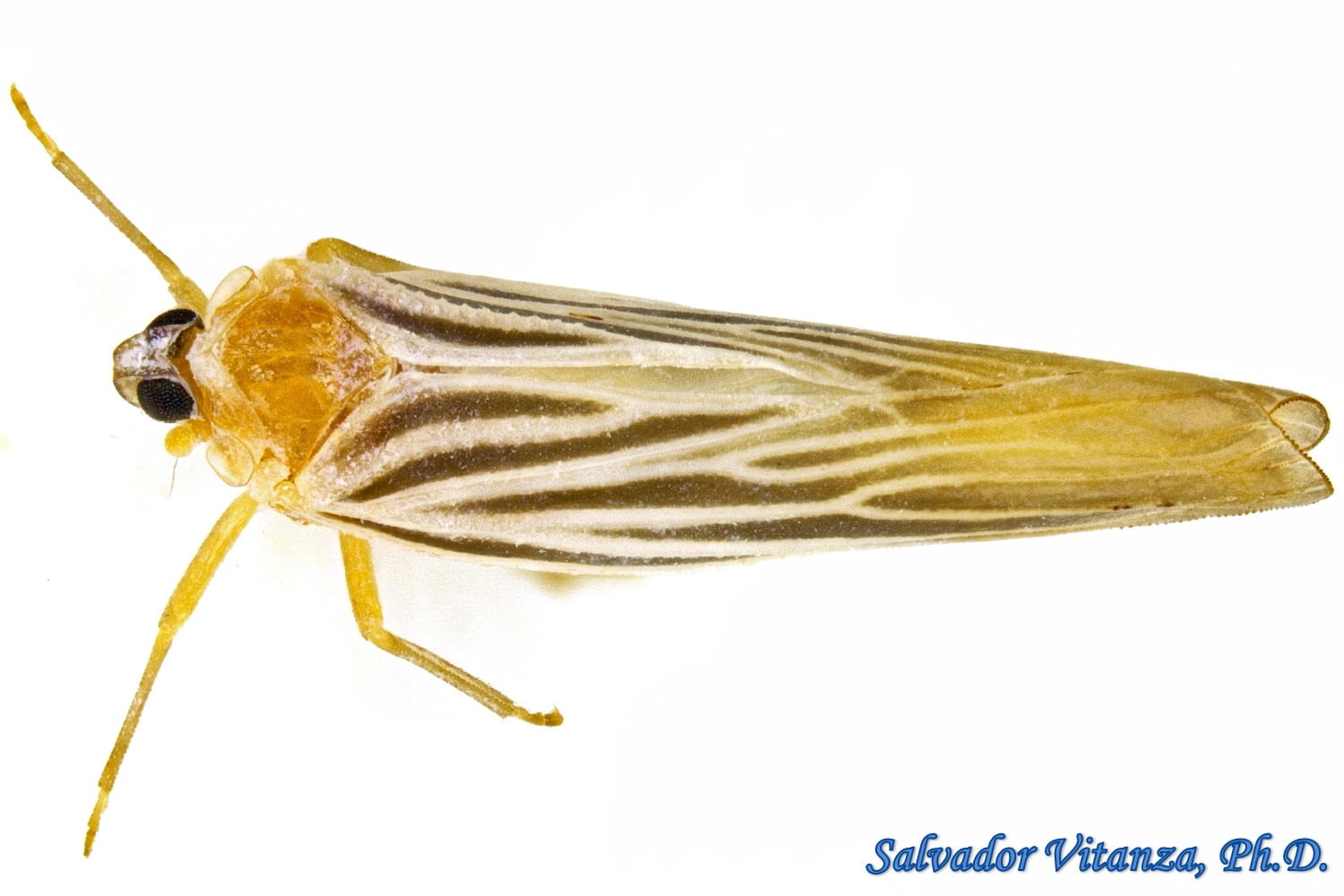[back to Classification of the Derbidae]
[back to North American Derbidae]
Contents
- 1 Family Derbidae Spinola 1839
- 1.0.0.1 Subfamily Derbinae Spinola 1839
- 1.0.0.2 Tribe Cenchreini Muir, 1917
- 1.0.0.3 Genus Persis Stål, 1862
- 1.0.0.4 Subgenera
- 1.0.0.5 Distribution
- 1.0.0.6 Recognized species
- 1.0.0.7 Economic Importance
- 1.0.0.8 Plant associations
- 1.0.0.9 Recognition
- 1.0.0.10 Online resources
- 1.0.0.11 Collecting
- 1.0.0.12 Molecular resources
- 1.0.0.13 Selected references
Family Derbidae Spinola 1839
Subfamily Derbinae Spinola 1839
Tribe Cenchreini Muir, 1917
Genus Persis Stål, 1862
Type species:Persis pugnax Stål, 1862c
Synonyms: None.
Subgenera
Persis (Anapersis) Fennah, 1952 (type species Neocenchrea gregaria Fennah 1945)
Persis (Eritalaena) Fennah, 1952 (Type species Persis fuscinervis Muir 1918: 417)
Persis (Persis) Stål, 1862 (type species Persis pugnax Stål, 1862)
Distribution
Southwestern USA and Neotropics.
Recognized species
Two species occur in the southwestern US, the remaining species are Neotropical. [Genus Metcalf 1945: 90].
This key, extracted out of Fennah (1952) should work
1. Subcostal cell long …Persis (Anapersis)
1.’ Subcostal cell short … 2
2. Vertex markedly produced before eyes, acutely angulate in profile … Persis (Persis)
2.’ Vertex not produced, forming with frons an obtuse angle in profile … Persis (Eritalaena)
Subgenus Persis Stal
Persis (Persis) fabriciana Metcalf 1938: 326 (replacement name for Cicada lineata Fabricius 1803: 66) – South America
Persis (Persis) foveatis Caldwell 1944: 106 – Mexico
Persis (Persis) novacula Fennah 1952: 140 – Trinidad
Persis (Persis) pugnax Stal 1862: 8 – Brazil (Rio de Janeiro)
Persis (Persis) stali Muir 1918: 417 – Guyana, Suriname
Subgenus Anapersis Fennah, 1952: 140
Persis (Anapersis) arizonensis O’Brien 1986: 72 – USA: AZ; Mexico (Sonora)
Persis (Anapersis) ferox O’Brien 1986: 70 – USA: AZ; Mexico (Sonora)
Persis (Anapersis) gregaria (Fennah 1945) – Trinidad, St. Vincent, Grenada, St. Lucia
= Neocenchrea gregaria Fennah 1945: 44, original combination.
= Persis (Anapersis) gregaria (Fennah 1945), comb. by Fennah 1952: 141,
Persis (Anapersis) pallescens (Metcalf 1938: 332) – Panama
Persis (Anapersis) spreta (Fowler 1900: 74) – Mexico (Tabasco)
= Mysidia ? spreta Fowler, 1900.
= Basileocephalus spreta (Fowler, 1900) by Muir 1918: 230.
= Neocenchrea spreta (Fowler, 1900) by Metcalf 1938: 331.
= Persis (Anapersis) spreta (Fowler, 1900) by Fennah 1952: 141.
Subgenus Eritalaena Fennah, 1952: 142
Persis (Eritalaena) fuscinervis Muir 1918: 417 – Guyana
Economic Importance
Limited.
Plant associations
None.
Hosts from Wilson et al. 1994; plant names from USDA PLANTS or Tropicos.
Recognition
A provisional key to the genera of Cenchreini is here.
Pale, robust; frons compressed but not extremely; lateral margins of pronotum weakly modified, pustules along claval vein; clavus closed, media and cubitus each with 2 branches; pygofer with medioventral process.
Subgenus Persis: Vertex markedly produced before eyes, acutely angulate in profile (vs. Eritalaena Fennah 1952); antennal fovea absent
Subgenus Eritalaena Vertex not produced, forming with frons an obtuse angle in profile (vs. s.g. Persis)
Head without a subantennal process ; tegmina fully three times as long as broad; a distinct Sc+ R + M stalk ; Sc + R fork at least distad of basal third, M3 and M4 united in a common stalk as far as subapical cross-veins (vs. Goneokara Muir)
Subgenus Anapersis (vs Eritalaena and Persis): Lateral pronotal carinae and ventral margins of pronotum foliate, forming an antennal fovea; (vs. Neocenchrea); Tegmina with papillate portion of anterior margin distinctly shorter than smooth basal portion (node distad of middle); pygofer with a medioventral process
Persis arizonensis (Patagonia, Santa Cruz County, Arizona 31.540307, -110.731207 Sept 17, 2018)
Persis (Persis) stali and Persis (Persis) novacula from Fennah 1952
Description of subgenus Persis from Fennah 1952
Head compressed, in profile more or less acutely angulate at apex; vertex elongate, narrow, tapering distally; lateral margins elevated ; frons elongate, narrow, with lateral carinae subparallel and raised; eyes excavate posteroventrally ; antennae short, subglobose. Pronotum very short, laterally wider, with a low curved ridge behind eyes and lateral margin shallow but definitely laminate, bounding an extremely shallow antennal fovea. Tegmina long, narrow, almost parallel-sided; Sc+R fork slightly basad of middle, M forked about level with apex of clavus, Cu1 forked about level with Sc+R fork, R and both branches of M forked near apex.
Persis (Anapersis) spreta from Fennah, 1952
Persis (Anapersis) gegaria from Fennah 1952
Description of subgenus Anapersis from Fennah (1952), with comments
Head with eyes narrower than pronotum; vertex about l.5 times as long as broad, with straight sides narrowing anteriorly; width at apex about half width at base; anterior margin carinate, transverse; posterior margin subrectanugulately excavate, disc moderately depressed; lateral margins in profile horizontal, meetmg those of frons subangulately; frons moderately narrow, medially ecarinate; lateral margins raised, not quite parallel, gradually widening from base to apex; subantennal process absent; antennae with first joint short, ringlike, second short, obovate; clypeus about as long as frons, tricarinate, rostrum just attaining post-trochanters. Pronotum widely angulately excavate posteriorly; median carina prominent, elevated; sublateral areas strongly inclined away from it to lateral margins; lateral marginal carinae forming a fovea, with the dorsal margin foliate, not merely carinate; mesonotum slightly broader than long, feebly tricarinate. Tegmina long, costal and commissural margins parallel, apical margin anteriorly rounded, then straight and obliquely truncate. Sc + R + M fork at basal fifth, Sc+R
forking basad of, and M forked about level with, apex of clavus, Cu1 forked about level with union of claval veins, Sc and R together with three branches at apical margin, M with 4, Cu1 with 2. Wings ample, only a little shorter than commissural margin of tegmina; R simple to
apex, M simple, Cu1 with two branches. Anal segment of male relatively long and narrow with anal style near apex. Pygofer with a well-developed medio-ventral process.
Anal segment of female short, broader than long. Pregenital sternite broadly produced and rather deeply rounded on posterior margin, in profile shallowly sinuate.
This subgenus is distinguished from typical Persis by the prominent pronotal foveae, which are obsolete in Persis, and by the narrow form of the medioventral process of the pygofer. The profile of the head is considerably different. The subgenus differs from Neocenchrea, to which its type species was originally referred, in shape of head, in the presence of a carina between vertex and frons, in the more strongly developed dorsal margin of the pronotal foveae, in the relatively broader mesonotum, in the shape of the tegmina, in the presence of a medioventral process on the pygofer and in the pattern of the aedeagus and genital styles.
Description of Persis (Eritalaena) from Fennah, 1952
Vertex with lateral margins in profile horizontal, little produced beyond level of eyes, rounding into base of frons; frons moderately narrow, medially ecarinate, lateral margins elevated, subparallel; no subantennal process on genae; antennae with first segment short; ring-like, second short subovoid; clypeus about as long as frons. Pronotum with marginal carinae obsolete, no antennal fovea developed. Tegmina long, costal and commissural margins parallel, apical margin rounded Sc+R+M fork at basal fifth, Sc+R forking basad of, and M forked about level with, apex of clavus; Cu, forked almost level with union of claval veins, Sc and R together with 3 branches at margin, M with 4 and Cu1 with 2. Anal segment of male relatively long and narrow with anal style near apex. Pygofer
with a short triangular medioventral process. Anal segment of female short, broader than long. Pregenital sternite produced on hind margin in a large deeply rounded lobe which is longer than basal part of sternite.
This subgenus is distinguished from the typical subgenus and from Anapersis by the shape of the head in profile, by the absence of distinct lateral carinae on the pronotum, by the shape of the medioventral process of the pygofer and of the posterior lobe of the pregenital sternite.
Online resources
FLOW.
GBIF.
Discover Life.
Extension education in El Paso, TAMU.
BOLD (subfamily, genus not present)
iNaturalist.
Flickr.
Collecting
Attracted to mercury vapor lights
Molecular resources
As of this writing, there are appears to be no molecular data for this genus on Barcode of Life or Genbank.
Selected references
Bartlett, C. R., L. B. O’Brien and S. W. Wilson. 2014. A review of the planthoppers (Hemiptera: Fulgoroidea) of the United States. Memoirs of the American Entomological Society 50: 1-287.
Caldwell, J. S. 1944. The tribe Cenchreini with special references to the Cenchrea complex (Homoptera: Derbidae). Bulletin of the Brooklyn Entomological Society 39: 99-110.
Emeljanov, A. F. 1995. On the problem of a system and a phylogeny of the family Derbidae (Homoptera, Cicadina). Entomologicheskoe Obozrenie 73(4): 783-811 & 946-947. [Russian] [English Transaltion: Emeljanov.1996. Entomological Review 75(2): 70-100]
Fennah, R. G. 1945. New Lanternflies (Fulgoroidea) From South America. Proceedings of the United States National Museum 96(3189): 95-106.
Fennah, R. G. 1952. On the generic classification of Derbidae (Fulgoroidea), with descriptions of new Neotropical species. Transactions of the Royal Entomological Society of London 103(4): 109-170.
Fowler, W. W. 1900. Order Rhynchota. Suborder Hemiptera-Homoptera. (Continued). Key to the genera of the subfamily Ricaniinae and descriptions of the n. spp. of this subfamily and the family Derbidae. Biologia Centrali-Americana 1: 57-76.
McAtee, W. L. 1924. Notes on Cenchrea Westwood and Cedusa Fowler in America (Homoptera: Fulgoroidea). Annals of the Entomological Society of America 17: 175-187.
Metcalf, Z. P. 1938. The Fulgorina of Barro Colorado and other parts of Panama. Bulletin of the Museum of Comparative Zoology, Harvard Collections. 82: 277-423. (see p. 326)
Metcalf, Z. P. 1945. Fulgoroidea (Homoptera) of Kartabo, Bartica District, British Guiana. Zoologica [Scientific contributions of the New York Zoological Society] 30(3): 125-143.
Metcalf, Z. P. 1945. General Catalogue of the Hemiptera. Fascicle IV, Fulgoroidea, Part 4, Derbidae. Smith College, Northhampton, Massachusetts. (p. 90)
Muir, F. A. G. 1917. The Derbidae of the Philippine Islands. Philippine Journal of Science 12: 49-105.
Muir F. A. G. 1918. Homopterous notes II. Proceedings of the Hawaiian Entomological Society. Honolulu 3: 414-429.
O’Brien, L. B. 1986. Five new species of Fulgoroidea (Homoptera) from the western United States and Mexico. Southwestern Entomologist 11(2): 67-74.
Stål, C. 1862c. Bidrag till Rio de Janeiro-tratkens Hemipterfauna. II. Handlingar. Kongliga Svenska Vetenskaps Akademien. Stockholm 3(6): 1-75.
Wilson, S. W., C. Mitter, R. F. Denno and M. R. Wilson.1994. Evolutionary patterns of host plant use by delphacid planthoppers and their relatives. In: R. F. Denno and T. J. Perfect, (eds.). Planthoppers: Their Ecology and Management. Chapman and Hall, New York. Pp. 7-45 & Appendix.










